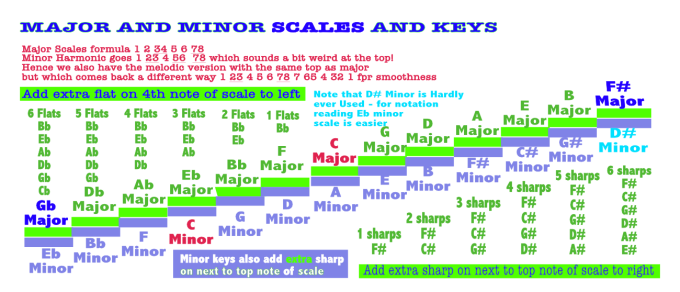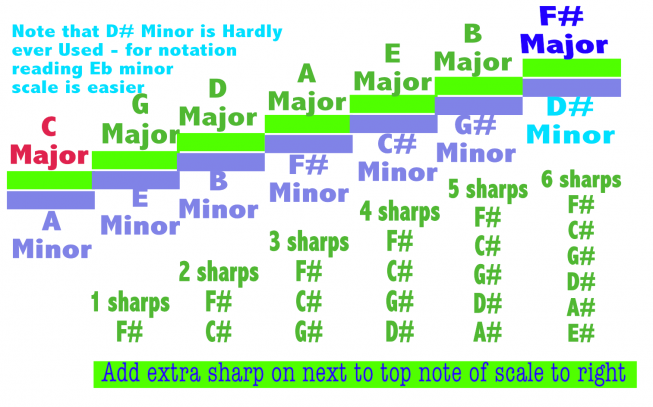Easy to understand Scales and keys
The keys are usually represented as the Circle of Keys because by the time you get to an extreme sharp key like F sharp you can rename it to G flat.
This is the same scale actually with different names applied to it and rather than go in that direction and produce keys which will need even more sharps and even double sharps by reducing the number of flats in the new equivalent we actually work back to C with no sharps or flats.
I think the diagram I have devised below with the keys and scales arranged in staircase form tells us quite a lot, but there is so much to view there there that we will also go through sections of it later on if you click or scroll down below

 The Sharp Keys in close Up
The Sharp Keys in close Up
The Right hand part of the picture
Below is a close up of the right hand section. You can see the gradual build up of the sharps in keys which are spaced five letters apart.
Starting with the C Major Scale, which does not need any sharps and flats to give the major scale

 For The Flat Keys, the left hand side of the Full Diagram, top of page
For The Flat Keys, the left hand side of the Full Diagram, top of page
The diagram below shows a close-up of the Flat keyssection of the bit introductory diagram on thispage.
The key C, with no sharps or flats would have been further right on the complete diagram.
In this staircase of keys and scales the keys are also spaced five note names apart and each successive key to the left adds an extra flat on the 4th note of the original scale
As a "cheat" you will notice that it is also one tone below the key with one flat fewer!

How are the Major Scales and keys made up?
Major scales are made up of two four note halves which are the same shape. Notes 1 2 34 is similar to 5 6 78. In both cases the last two notes are only a semitone apart.
In no other places in the major scale does this happen And that includes of course the gap between the two halves of the scsle!
The sharps and flats are added of course to make the major scale shape right.
The video below shows how you add sharps on the keyboard as you move up a half scale, or add flats (or deduct sharps if there are any) each time you go an extra half scale to the left. These are called tetrachords by the way.
Experimenting on the keyboard like this is a good way to get an understanding.
 A short video on making major and minor chords and arpeggios and practising them
A short video on making major and minor chords and arpeggios and practising them
Fingering keys F C G D A E B
You do not have to learn many different fingerings for scales This even works for the minor scales
RIGHT HAND UPWARDS
The thumb gets in quickly on the 4th note after 3 (middle finger). To do a further octave the thumb starts again on the key note - and repeat
LEFT HAND DOWNWARDS
The same as right hand upwards
LEFT HAND UPWARDS
Start on 5, cross to 3 when forced because thumb has arrived cross to 4 for a further octave
Fingering for Bb Eb Ab Db Gb
WARNING
The tnumb or little finger is never used on the keynote
RIGHT HAND UPWARDS
The thumb gets in regularly on C and F note after 3 (middle finger). To do a further octave the thumb starts again after 4 as the key nlote - and repeat
LEFT HAND DOWNWARDS
The same as right hand upwards
LEFT HAND UPWARDS
Start on 5, cross to 3 when forced because thumb has arrived cross to 4 for a further octave
Working out how the scales and keys work on your piano keyboard
How to work out minor scales
First here is a really fabulous cheat!
In the diagram of all the major and minor scales you see what the "relative minor" keys are but what if you can work out easily and logically how they match up without studying it.
 If you want to know what the key signature of F minor is do you know what the middle note of a basic F minor chord is? It is A flat right?
If you want to know what the key signature of F minor is do you know what the middle note of a basic F minor chord is? It is A flat right?
The key signature you want for the key of F minor is four flats, the same as for A flat. So the key signature for F minor isfour flats, the same as that for Ab,
Just look for the middle note of the minor chord the scale is named after and it gives you the relative major key signature.
How do you apply the minor key signatures?
Not so straightforward as the major scales but we can still explain it first. Even though there are two versions of the minor scale!
For the Harmonic Minor - remember this is the one that wants to supply the harmony correctly, it is not too bothered about the melody
Take the key siignature literally but when you get to the seventh note of the scale which needs to make a niice close connection to the top key note you sharpen the 7th note of the scake
Hence for D minor the harmonic scale is
D E F G A Bb C# D
Like the Major scales the same going up as going down
This looks wrong to mix sharps and flats. Bit it supplies the right chords for the key signature.
Yhe harmonic minor scale also sounds wrong, which is why we need the melodic minor scale, to make pleasant tunes out of.
.
However the Melodic Minor Scale is crazy in its own way!
The top half works differently depending on which direction it is going!
On the way down it behaves perfectly following the sharps or flats exactly as shown in the key signature.
So going down for D minor nelodic is D C Bb A G F E D
But on the way up only the first half is minor, - the upward second half is exactly the same as that of the Major scale.
This is achieved with accidentals, notes adjusted as you go along, and is not shown in the key signature at the beginnigng og every stave
So an up and down D minor scale key signature of F goes
D E F G A B C# D C natural Bb A G F E D





